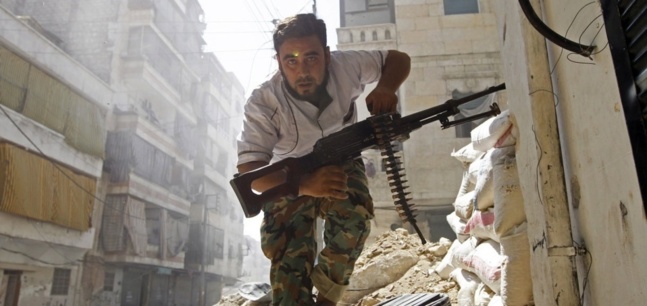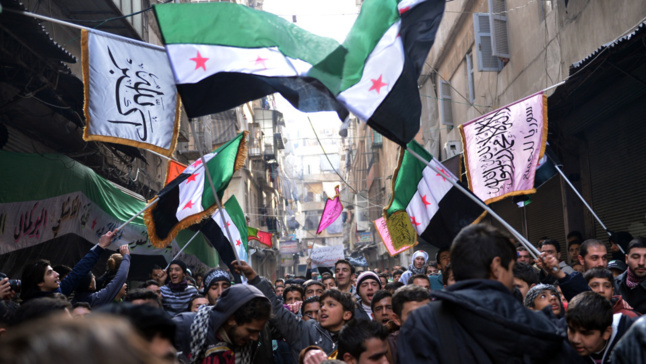
@Goran Tomasevic/Reuters
The answer is nuanced, but one cannot deny that Syria is now centerpiece of war and a strategic conflict between Iran and the Gulf monarchies. The former wishes to hold the Syrian regime in place to keep its influence in the region, whereas the Gulf countries want the opposite. They hope for change, and leverage the crisis as a catalyst in reducing Iran’s hegemony in the region. The interaction between Hezbollah fighters, the pro-Al Assad regime acting under the orders of Iran, and those of the Free Syrian Army, supported financially and militarily by the Gulf countries and Western countries such as Turkey, is the perfect poster child of the Syrian crisis.
It appears clear that the Syrian crisis reflects a proxy war between regional rivals. To understand this, it is interesting to examine the extensive role of strategy within the Syrian crisis, whose consequences will impact the future of Syria and the stability of the entire region.
It appears clear that the Syrian crisis reflects a proxy war between regional rivals. To understand this, it is interesting to examine the extensive role of strategy within the Syrian crisis, whose consequences will impact the future of Syria and the stability of the entire region.
Strategizing the Syrian crisis
Relations between Iran and the Gulf monarchies are tense due to both the religious rivalry between Shiites and Sunnis and thus their negative perceptions of each other. The Syrian revolution reinforces these tensions in providing a strategic platform for their differences.
The Syrian crisis develops a major strategic issue for both Iran and the Gulf monarchies. The Gulf monarchies see the overthrow of the Bachar Al Assad regime in Syria as an opportunity to isolate Iran and quickly deactivate its regional domination. These countries, including Saudi Arabia, Qatar and Turkey, did not hesitate to send their political and financial support to the Syrian opposition in its war against the troops of the Al Assad regime.
From a political standpoint, the Gulf countries immediately acknowledged "the national coalition of Syrian opposition forces and revolution", expressing a step forward to a rapid transfer of power in Syria, and thus proof of the Gulf countries’ involvement against the Syrian regime.
Their support is not limited to the political arena. Wealthy states like Qatar and Saudi Arabia give financial and military support (in the form of weapons) to fulfill the Syrian opposition’s needs. The Gulf countries are committed to depriving the Iranian regime of an important ally in the region, as well as to breaking the Shiite axis.
The Syrian crisis develops a major strategic issue for both Iran and the Gulf monarchies. The Gulf monarchies see the overthrow of the Bachar Al Assad regime in Syria as an opportunity to isolate Iran and quickly deactivate its regional domination. These countries, including Saudi Arabia, Qatar and Turkey, did not hesitate to send their political and financial support to the Syrian opposition in its war against the troops of the Al Assad regime.
From a political standpoint, the Gulf countries immediately acknowledged "the national coalition of Syrian opposition forces and revolution", expressing a step forward to a rapid transfer of power in Syria, and thus proof of the Gulf countries’ involvement against the Syrian regime.
Their support is not limited to the political arena. Wealthy states like Qatar and Saudi Arabia give financial and military support (in the form of weapons) to fulfill the Syrian opposition’s needs. The Gulf countries are committed to depriving the Iranian regime of an important ally in the region, as well as to breaking the Shiite axis.
Iran against the Gulf countries’ policies
Aware of what’s at stake, Iran intends to defend its strategic interests and continue to dominate the region. Iranian authorities use their influence to support the regime of Bachar Al Assad against the opposition forces that become stronger and stronger each day. Iran does not hesitate to finance the army of the Syrian regime by sending arms and fighters. So far an estimated 50,000 Iranian soldiers have been sent, most of them being Hezbollah supporters.
Thus, it is clear that the Syrian crisis is, in reality, a proxy war between Iran and the Gulf countries. The conflict is further egged on by international powers where Russia is in support of Iran and the United States, European countries and Turkey are in favour of the Gulf countries.
Thus, it is clear that the Syrian crisis is, in reality, a proxy war between Iran and the Gulf countries. The conflict is further egged on by international powers where Russia is in support of Iran and the United States, European countries and Turkey are in favour of the Gulf countries.
The Risks of strategizing the Syrian crisis

Two major risks can be caused by these interferences. The intense civil war could potentially destroy Syria and at the same time undermine the stability of the entire Middle East. The war reinforces a nation-wide divide: Syria’s multi-sector social fabric is characterized by the presence of several ethnic groups (Shiites, Sunnis Alawites, Christians...), and the war only increases the threat of national implosion. In fact, the war is at a standstill: the two sides continue to neutralize each other because neither party is willing to cease fire.
This situation could accelerate the dissension among multiple communities, mainly between the Shiites supported by Iran and by Gulf countries, which will probably lead to the Balkanization of Syria, like Iraq in 2003 after the end of the U.S. military intervention.
The other major risk would be that the Syrian crisis could generate a "contagion of chaos" in the region, including Lebanon, Jordan and Iraq, already weakened by internal conflict, particularly in the Sahel region. This armed conflict could have similar results to the war in Libya, where NATO forces destroyed the Gaddafi regime, but consequently weakened the Sahel region’s defense system, an area currently threatened by Al Qaida and their allies. Libya 2.0 could likely occur in the Middle East, especially with the presence of weapons at hand, jihadists and terrorists like Al Qaeda in Iraq.
Additionally, the escalation of tensions between Hezbollah and the Free Syrian Army, as well as security incidents on the Iraq-Syria border (including a deadly attack in Iraq killing 42 Syrian soldiers) perfectly demonstrates the fragility of the region and its vulnerability to the crisis.
Moreover, involvement of the Gulf monarchies in Syria could lead Iran to react later against their political stability and security, for example through Shiiâ groups living in the Gulf as it was the case in Bahrain, which could pave the way for a direct confrontation.
The external involvement in the Syrian crisis only worsens the situation. It is the time to find a peaceful political compromise for all.
This situation could accelerate the dissension among multiple communities, mainly between the Shiites supported by Iran and by Gulf countries, which will probably lead to the Balkanization of Syria, like Iraq in 2003 after the end of the U.S. military intervention.
The other major risk would be that the Syrian crisis could generate a "contagion of chaos" in the region, including Lebanon, Jordan and Iraq, already weakened by internal conflict, particularly in the Sahel region. This armed conflict could have similar results to the war in Libya, where NATO forces destroyed the Gaddafi regime, but consequently weakened the Sahel region’s defense system, an area currently threatened by Al Qaida and their allies. Libya 2.0 could likely occur in the Middle East, especially with the presence of weapons at hand, jihadists and terrorists like Al Qaeda in Iraq.
Additionally, the escalation of tensions between Hezbollah and the Free Syrian Army, as well as security incidents on the Iraq-Syria border (including a deadly attack in Iraq killing 42 Syrian soldiers) perfectly demonstrates the fragility of the region and its vulnerability to the crisis.
Moreover, involvement of the Gulf monarchies in Syria could lead Iran to react later against their political stability and security, for example through Shiiâ groups living in the Gulf as it was the case in Bahrain, which could pave the way for a direct confrontation.
The external involvement in the Syrian crisis only worsens the situation. It is the time to find a peaceful political compromise for all.





























